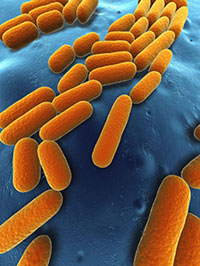| Sep 17, 2013 | |
Predictive model a step toward using bacteria as a renewable fuel source |
|
| (Nanowerk News) A new transcriptomics-based model accurately predicts how much isoprene the bacterium Bacillus subtilis will produce when stressed or nourished. | |
 A new transcriptomics-based model that accurately predicts how much isoprene the bacterium Bacillus subtilis will produce is a step toward using bacteria as a clean, renewable fuel source. This model marks a step toward understanding how changes in the bacteria’s environment affect gene expression and, in turn, isoprene production ("Coregulation of Terpenoid Pathway Genes and Prediction of Isoprene Production in Bacillus subtilis Using Transcriptomics"). Isoprene is a volatile liquid currently derived from oil that is used for aviation fuel and industrial applications. Potentially, isoprene could be derived from bacteria which, like plant and animal cells, produce it in small amounts to serve important signaling and structural roles. With an eye toward maximizing isoprene production in bacteria, a team of Environmental Molecular Sciences Laboratory (EMSL) staff and users sought to understand isoprene regulation in B. subtilis, a bacterium that naturally produces more isoprene than other microbes. The team treated B. subtilis with 30 different chemical stressors and nutrients that alter isoprene production and then analyzed the expression of over 4100 genes. Transcriptomics data showed that of the 4100 genes, 213 genes influenced, or regulated, isoprene production. With these 213 genes, the team built a statistical model that accurately predicts isoprene production levels in B. subtilis under different conditions, indicating that transcriptomics measurements alone can provide the necessary information to understand what cellular states are conducive to making isoprene. This fundamental insight into isoprene regulation in bacteria is helping advance synthetic biology approaches to engineer microbes to produce isoprene as well as other high-value metabolites. |
| Source: Environmental Molecular Sciences Laboratory |
